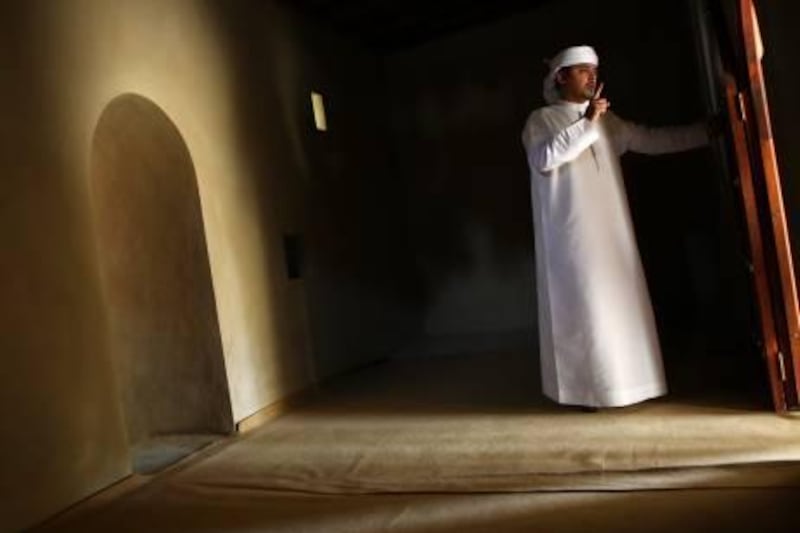AL AIN // Beneath every historical building, a tiny, relentless force is at work. It cannot be stopped; but unless it is restrained, conservationists say it could reduce the city's historic houses, forts and mosques to dust.
Countless billions of termites, each just a few millimetres long but together forming a powerful, ravenous army, are on the attack.
Heritage officials say they have found them in 10 historical buildings in Al Ain and the Western Region, but believe the problem goes far beyond that. The Abu Dhabi Authority for Heritage and Culture (Adach), which runs conservation projects, believes the insects lurk beneath pretty much every historical building in town.
For the past few months, they have been largely dormant - winter, experts say, is too cold for them. But as the summer approaches, the destruction is set to gather pace.
Conservationists have tried to control the wood-eaters in four of those buildings so far, including Jahili fort, Jahili mosque, Qattara fort and Muwaiji fort.
Adach is also developing a research programme on termites and plans to produce a handbook with advice on how to deal with the tiny menace.
"We cannot get rid of them completely, but we can control them," said Aqil Aqil, a historical building conservationist. "Termites are a problem in the UAE. I can guarantee they are in all buildings. Al Ain has a high level of termites."
Although a member of the same family of insects as the cockroach, termites have a far more complex societal structure, more like that of ants or bees.
At the top is the queen, essentially an egg-laying machine. Although the front of her body is typically only a little bigger than that of other termites, her hind quarters are huge - several centimetres long and a centimetre or more thick. The kings, too, are larger than normal, but without the sack of maggot-like eggs.
Only the kings and queens reproduce. The vast bulk of the rest of the colony consists of infertile drones whose sole purpose in life is to make sure their king and queen pass on their genes to a new generation.
Among these drones are the soldiers, armed with huge jaws they use in combat, either with rival colonies or to fend off any predators or pests they may come across.
The damage, though, is done by the workers. The termites in Al Ain are of a fairly primitive species; while other types build huge mounds, these live entirely underground, digging large networks of tunnels and chambers through wood and soil alike.
That, Mr Aqil said, is what makes them dangerous. "The ones we are worried about here are the 'workers'. They get food for the colony and dig tunnels."
And Al Ain's old mud-and-straw buildings are a rich source of food.
"Beams, doors and door lintels, they are all wooden. Even the walls have straw. Termites eat straw, anything like wood. Wooden elements are the structural basis for these buildings."
New buildings can face infestations, too, according to Dinesh Ramachandran, technical director at the National Pest Control, which has offices in Abu Dhabi, Dubai and Sharjah. House-buyers, he said, should beware.
And it is not enough to rely on spotting the insects by eye - they tend to steer clear of sunlight and rarely come to the surface. "You will not see them until damage is done in the building," Mr Ramachandran said.
"Before buying a house, ask the landlord if the place has been treated for termites, and when," he advised. "If it has not, then get a termite expert to inspect the building."
So how to spot them? "If we see mud tunnels, we know there are termites because termites don't like to be in the sun," Mr Aqil said.
"If the hole in the wood is big, it's usually not termites - they don't like the sun. That is what makes them dangerous, you cannot see them. We are losing history of the buildings."
The traditional extermination method is to dip affected wood into petrol. But not only does that smell bad and discolour the wood, the anti-termite effect does not last long - a few months, at most.
Once it is worked out where the termites are, wood traps are set underground to determine the scale of the infestation.
The traps are checked every month to see whether they have been invaded. If they have, they are replaced with toxic wood to kill them.
Adach also dips or sprays wood from the buildings with insecticides.The treatment has to be calibrated to the exact nature of an infestation. "Sometimes we need to get rid of the termites immediately because we want to open a place to the public by the end of the year," Mr Aqil said. "But either way - have to keep monitoring the buildings."
Baiting, though, is usually best. "Ninety per cent of the time I recommend the baiting system," Mr Ramachandran said. "It is non- chemical, not harmful to the soil."






